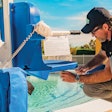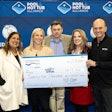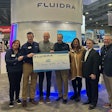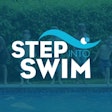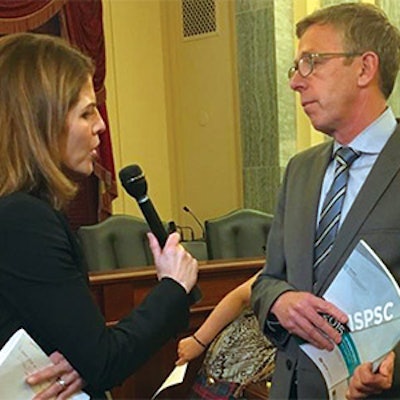
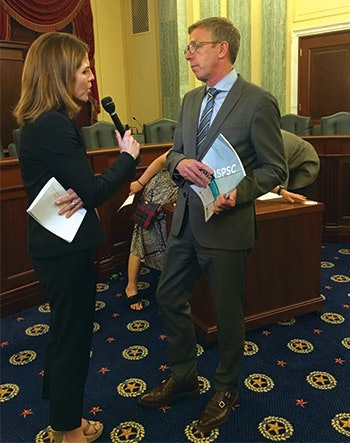 APSP President and CEO Rich Gottwald discusses the future of VGB with an ABC news correspondent at the VGB hearing.
APSP President and CEO Rich Gottwald discusses the future of VGB with an ABC news correspondent at the VGB hearing.
On the 10th anniversary of the Virginia Graeme Baker Pool and Spa Safety Act, APSP testified on Capitol Hill and called upon senators to recognize and support statewide adoption of the International Swimming Pool & Spa Code.
To say that the Virginia Graeme Baker Pool and Spa Safety Act was a seismic event in the industry's history is an understatement. Since its inception, not one fatality has been reported in a public pool due to suction entrapment. But recent Senate testimony made it clear that an even bigger challenge is coming: protecting the millions of swimmers in the residential pool and spa environment.
Just before the Memorial Day weekend, APSP President and CEO Rich Gottwald testified (see written testimony below) on behalf of the industry before the Senate Subcommittee on Consumer Protection, Product Safety, Insurance, and Data Security, regarding the effectiveness of the Virginia Graeme Baker Pool and Spa Safety Act. He was joined by Nancy Baker, mother of Virginia Graeme Baker; Karen Cohn, co-founder of The ZAC Foundation; and Connie Harvey, director of Aquatics Centennial Initiatives at the American Red Cross.
RELATED: VGB 10 Years After
The efficacy of the VGB Act was lauded, but Baker, Cohn and Harvey noted there is much work to done. "The role of government in many issues relating to the safety of children is without question a critical one," Baker stated. Citing the government's role in vaccinations, smoke alarms, car safety and many others, Baker acknowledged that the government has played a critical and active role in establishing standards to protect vulnerable populations. "The Virginia Graeme Baker Pool and Spa Safety Act is one such effort and it is an example of many constituencies working together, engaging in debate and reconciliation in order to remedy a public health crisis."
Answering the Challenge to Move Beyond Public Pools
 Senators Moran, Blumenthal and Nelson hear testimony from APSP president and CEO Rich Gottwald at the subcommittee hearing.
Senators Moran, Blumenthal and Nelson hear testimony from APSP president and CEO Rich Gottwald at the subcommittee hearing.
While the industry has spent the past decade adhering to the requirements of VGB, APSP laid the groundwork to go above and beyond VGB. Through its ANSI standards program and its collaboration with the International Code Council, APSP developed the comprehensive International Swimming Pool & Spa Code to protect all pools, spas and hot tubs.
To date, this code has been or is in the process of being adopted by 22 states, 11 of which are mandatory adoptions. In addition, there are 73 local jurisdictions across the country that have adopted the ISPSC. When adopted, it will provide the same level of safety protection for newly installed residential pools and spas that the VGB now mandates for public pools and spas.
While some of the questions from senators during the hearing focused on how to promote water safety and swimming, the overarching message was that all safety measures, including laws, ISPSC, education and swimming lessons will help reduce drowning.
"We believe in VGB because it has worked," Gottwald said. "We also believe that the states' adoption of The International Swimming Pool & Spa Code will prevent drownings because it not only addresses suction entrapment prevention, but also provides barrier protection requirements." Gottwald emphasized to the senators that APSP was working for state and local jurisdiction adoption of the ISPSC as a key way to go above and beyond VGB.
Cohn, who lost her son to entrapment, is encouraged by her work with other aquatic organizations and families of children who have drowned. She insisted that drowning is a problem that is completely preventable when all water safety stakeholders are doing their part and working together.
One example of collaboration in water safety is the National Water Safety Month campaign. During the hearing on May 24, U.S. Senators Jerry Moran, R-Kan., and Richard Blumenthal, D-Conn., announced they had filed a resolution designating May as National Water Safety Month.
"It's clear from the Senate hearing that VGB has made pools and spas safer, but we all recognize that there is more to be done," Gottwald said. "It's our job to use our technical and standards expertise to advance water safety and adoption of ISPSC is the key."
To view all the Senate testimony and supporting documentation, visit APSP.org/VGBTestimony.
RELATED: VGB, ADA, ACA Explained
Statement on VGB
Statement of Richard Gottwald, APSP President & Chief Executive Officer, before the U.S. Senate Committee on Commerce, Science, & Transportation Subcommittee on Consumer Protection, Product Safety, Insurance, and Data Security Hearing on the 10th Anniversary of the Virginia Graeme Baker
Pool and Spa Safety Act, May 24, 2017:
Thank you, Chairman Moran, Ranking Member Blumenthal, and Members of the Subcommittee for holding this important hearing. It is an honor and a privilege for me to be here before you to mark the 10th anniversary of the Virginia Graeme Baker Pool and Spa Safety Act.
My name is Richard Gottwald and I am the President and CEO of The Association of Pool & Spa Professionals. APSP is the world's oldest and largest trade association representing the entire pool and spa supply chain: From pool, hot tub and spa manufacturers, to distributors, suppliers, and retailers, as well as the building and service professionals. We develop and promote the country's national consensus standards for pools, hot tubs and spas, and are the only pool and spa industry organization accredited by the American National Standards Institute since 1985 to do so. ANSI is a 100-year-old organization that serves as an administrator and coordinator of U.S. industry standards.
I appreciate the opportunity today to share with you how the Virginia Graeme Baker Pool and Spa Safety Act, or "VGB," has influenced the pool and spa industry, and how, 10 years later, we continue to educate and train our association and members on how to keep all pools and spas safe, including the public pools covered by the VGB Act, as well as the residential pools that were not covered by the law.
 APSP President and CEO Rich Gottwald testifies on behalf of the industry before the Senate Subcommittee on Consumer Protection, Product Safety, Insurance, and Data Security.
APSP President and CEO Rich Gottwald testifies on behalf of the industry before the Senate Subcommittee on Consumer Protection, Product Safety, Insurance, and Data Security.
History: A Seismic Shift
To say that the Virginia Graeme Baker Pool and Spa Safety Act was a seismic event in our industry is an understatement. In fact, VGB created a tsunami of safety awareness and education efforts by APSP and many others that reverberates today. Working with the family of Virginia Graeme Baker and SafeKids Worldwide, Congresswoman Debbie Wasserman Schultz first introduced the legislation in 2006. The industry immediately stated its support for mandating safety requirements in all pools and spas, and actively worked with all parties involved in this critical bill, leading to the second iteration of the bill that was signed into law on December 19, 2007.
As I mentioned earlier, APSP is the only industry organization accredited by ANSI to develop and promote the country's national consensus standards for pools, hot tubs and spas. Compliance with our ANSI/APSP-16 Standard for Suction Fittings for Use in Swimming Pools, Wading Pools, Spas, and Hot Tubs is a requirement of the VGB. This standard was developed and continues to improve with input from the Consumer Product Safety Commission staff and serves as an excellent example of collaboration between industry and government to protect all pool and spa users. A 2017 successor standard is slated to be adopted by this December.
In 2006, while the VGB was being finalized, APSP published the ANSI/APSP-7 Standard for Suction Entrapment Avoidance in Swimming Pools, Wading Pools, Spas, Hot Tubs, and Catch Basins. This standard is consistent with all of the provisions in the VGB and was the first comprehensive systems approach to engineering swimming pools and spas to eliminate suction entrapment events. It protects against the three root causes of entrapments: suction, water velocity, and mechanical binding. Based on sound science and best practices, this standard is consistent with and even exceeds the requirements in the Virginia Graeme Baker Pool and Spa Safety Act, current U.S. Consumer Product Safety Commission interpretations of the VGB, and model state legislation provided within the VGB Act.
In 2009, the ANSI/APSP-7 standard was recognized by the International Code Council in their International Building and Residential Codes and in 2012 was referenced in the International Swimming Pool and Spa Code. The ISPSC is the first ever all-inclusive comprehensive national code for swimming pools and spas developed in compliance with the principles defined by the OMB Circular A119, Federal Participation in the Development and Use of Voluntary Consensus Standards and in Conformity Assessment Activities, codified by Public Law 104-113, National Technology Transfer and Advancement Act of 1995. This key ANSI/APSP safety standard provides the ISPSC with the necessary model suction entrapment avoidance code language for national, state and local adoption. The ANSI/APSP-7 standard has been adopted, either directly, or through the ICC Codes, in over 20 states, with numerous local adoptions where statewide adoption is not required.
The ISPSC also requires barriers for all residential pools, consistent with the VGB model state legislation language. We continue to urge all states to adopt this code to protect all swimmers in both public and residential pools and spas. The CPSC stated that the ISPSC meets all of the requirements of the model state legislation and VGB State Grant Program.
Safety Awareness
The final passage of the Virginia Graeme Baker Pool & Spa Safety Act also assisted us in our efforts to communicate water safety messaging and information to our members, affiliate organizations and pool owners. Beyond the very important technical requirements that the VGB and the International Swimming Pool and Spa Code require, APSP sought a larger platform that would aim to promote safe water practices and prevent drowning and water-related injuries. Working collaboratively with the American Red Cross, the National Recreation and Park Association, and the World Waterpark Association, we launched the National Water Safety Month campaign, which is held every May. This month marks its 10th year anniversary. National Water Safety Month has gained attention from governors of all 50 states, who have signed water safety proclamations, and Olympic swimmers, who have highlighted the vital importance of public education regarding safer practices for kids and adults in and around the water. Throughout the month of May, thousands of aquatic facilities and professionals recognize this important month through educational programs, public service announcements, governmental proclamations and distribution of water safety materials, including CPSC's Pool Safely program materials. We remain committed to working with the Pool Safely Program and organizations like the National Drowning Prevention Alliance, recognizing and appreciating their outreach to swimmers, especially in minority communities.
In addition, APSP created the "Check A Drain" initiative that reminds our members throughout the year, especially at key swim times, to check their customers' drains to make sure both commercial and residential pools are in compliance with VGB. Since the adoption of the VGB, the APSP has actively urged and taught builders and service professionals to contact the millions of existing pool owners to replace pre-VGB drain covers.
Going Beyond Public Pools & Fighting for Adoption of ISPSC
Through our relationship with the International Code Council, our ANSI/APSP national consensus standards are incorporated into the International Swimming Pool and Spa Code. This first-ever comprehensive national pool and spa code was developed jointly by the APSP and ICC, with the first edition being published in March 2012. The third edition of this code is slated to be published this September. To date, this code has been or is in the process of being adopted by 22 states, 11 of which are mandatory adoptions (Louisiana, New Hampshire and Massachusetts are those states in the process of adopting before the end of the year). In addition, there are 73 local jurisdictions across the country that have adopted the ISPSC. When adopted, the International Swimming Pool and Spa Code will provide the same level of safety protection for newly installed residential pools and spas that the VGB now mandates for public pools and spas.
It is important to note that the ISPSC not only addresses suction entrapment prevention in pools and spas, but also provides barrier protection requirements in order to reduce the risk of unattended access to the pool or spa; understanding that the primary layer of protection is constant adult supervision of toddlers. Providing these pool safety requirements to prevent drownings is of utmost importance and we continue to encourage each and every state to adopt this code.
Conclusion
In conclusion, on behalf of APSP and its many members, we appreciate what this subcommittee is doing to support water safety and recognize the efforts of industry, the many safety organizations and advocates who have played a significant role in reducing these tragic incidents since the inception of the Virginia Graeme Baker Pool and Spa Safety Act, understanding there is more work to be done.
We hope the subcommittee members will recognize and support statewide adoption of the International Swimming Pool and Spa Code to now protect our residential pool and spa users thus finally protecting all our nations' swimmers. Thank you for the opportunity to testify.





























